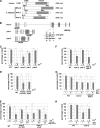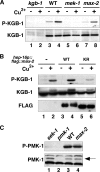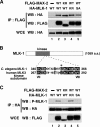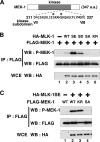The Caenorhabditis elegans Ste20-related kinase and Rac-type small GTPase regulate the c-Jun N-terminal kinase signaling pathway mediating the stress response
- PMID: 20008556
- PMCID: PMC2815562
- DOI: 10.1128/MCB.01131-09
The Caenorhabditis elegans Ste20-related kinase and Rac-type small GTPase regulate the c-Jun N-terminal kinase signaling pathway mediating the stress response
Abstract
Mitogen-activated protein kinases (MAPKs) are integral to the mechanisms by which cells respond to physiological stimuli and a wide variety of environmental stresses. In Caenorhabditis elegans, the stress response is controlled by a c-Jun N-terminal kinase (JNK)-like MAPK signaling pathway, which is regulated by MLK-1 MAPK kinase kinase (MAPKKK), MEK-1 MAPKK, and KGB-1 JNK-like MAPK. In this study, we identify the max-2 gene encoding a C. elegans Ste20-related protein kinase as a component functioning upstream of the MLK-1-MEK-1-KGB-1 pathway. The max-2 loss-of-function mutation is defective in activation of KGB-1, resulting in hypersensitivity to heavy metals. Biochemical analysis reveals that MAX-2 activates MLK-1 through direct phosphorylation of a specific residue in the activation loop of the MLK-1 kinase domain. Our genetic data presented here also show that MIG-2 small GTPase functions upstream of MAX-2 in the KGB-1 pathway. These results suggest that MAX-2 and MIG-2 play a crucial role in mediating the heavy metal stress response regulated by the KGB-1 pathway.
Figures









Similar articles
-
The Core Molecular Machinery Used for Engulfment of Apoptotic Cells Regulates the JNK Pathway Mediating Axon Regeneration in Caenorhabditis elegans.J Neurosci. 2016 Sep 14;36(37):9710-21. doi: 10.1523/JNEUROSCI.0453-16.2016. J Neurosci. 2016. PMID: 27629720 Free PMC article.
-
The Caenorhabditis elegans MAPK phosphatase VHP-1 mediates a novel JNK-like signaling pathway in stress response.EMBO J. 2004 Jun 2;23(11):2226-34. doi: 10.1038/sj.emboj.7600226. Epub 2004 Apr 29. EMBO J. 2004. PMID: 15116070 Free PMC article.
-
Role of the Caenorhabditis elegans Shc adaptor protein in the c-Jun N-terminal kinase signaling pathway.Mol Cell Biol. 2008 Dec;28(23):7041-9. doi: 10.1128/MCB.00938-08. Epub 2008 Sep 22. Mol Cell Biol. 2008. PMID: 18809575 Free PMC article.
-
Mixed-lineage kinase control of JNK and p38 MAPK pathways.Nat Rev Mol Cell Biol. 2002 Sep;3(9):663-72. doi: 10.1038/nrm906. Nat Rev Mol Cell Biol. 2002. PMID: 12209126 Review.
-
Factors regulating axon regeneration via JNK MAP kinase in Caenorhabditis elegans.J Biochem. 2020 May 1;167(5):433-439. doi: 10.1093/jb/mvaa020. J Biochem. 2020. PMID: 32091576 Review.
Cited by
-
The small GTPase ROP6 interacts with NFR5 and is involved in nodule formation in Lotus japonicus.Plant Physiol. 2012 May;159(1):131-43. doi: 10.1104/pp.112.197269. Epub 2012 Mar 20. Plant Physiol. 2012. PMID: 22434040 Free PMC article.
-
The Core Molecular Machinery Used for Engulfment of Apoptotic Cells Regulates the JNK Pathway Mediating Axon Regeneration in Caenorhabditis elegans.J Neurosci. 2016 Sep 14;36(37):9710-21. doi: 10.1523/JNEUROSCI.0453-16.2016. J Neurosci. 2016. PMID: 27629720 Free PMC article.
-
Redundant canonical and noncanonical Caenorhabditis elegans p21-activated kinase signaling governs distal tip cell migrations.G3 (Bethesda). 2013 Feb;3(2):181-95. doi: 10.1534/g3.112.004416. Epub 2013 Feb 1. G3 (Bethesda). 2013. PMID: 23390595 Free PMC article.
-
Deciphering the mechanism of anhydrobiosis in the entomopathogenic nematode Heterorhabditis indica through comparative transcriptomics.PLoS One. 2022 Oct 27;17(10):e0275342. doi: 10.1371/journal.pone.0275342. eCollection 2022. PLoS One. 2022. PMID: 36301967 Free PMC article.
-
Trauma-induced regulation of VHP-1 modulates the cellular response to mechanical stress.Nat Commun. 2021 Mar 5;12(1):1484. doi: 10.1038/s41467-021-21611-8. Nat Commun. 2021. PMID: 33674585 Free PMC article.
References
-
- Bossemeyer, D. 1995. Protein kinases—structure and function. FEBS Lett. 369:57-61. - PubMed
-
- Byrd, D. T., M. Kawasaki, M. Walcoff, N. Hisamoto, K. Matsumoto, and Y. Jin. 2001. UNC-16, a JNK-signaling scaffold protein, regulates vesicle transport in C. elegans. Neuron 32:787-800. - PubMed
-
- Chang, L., and M. Karin. 2001. Mammalian MAP kinase signalling cascades. Nature 410:37-40. - PubMed
-
- Dan, I., N. M. Watanabe, and A. Kusumi. 2001. The Ste20 group kinases as regulators of MAP kinase cascades. Trends Cell. Biol. 11:220-230. - PubMed
Publication types
MeSH terms
Substances
LinkOut - more resources
Full Text Sources
Molecular Biology Databases
Research Materials
Miscellaneous
